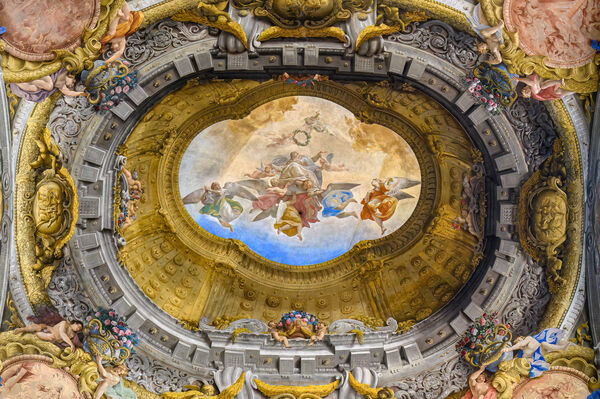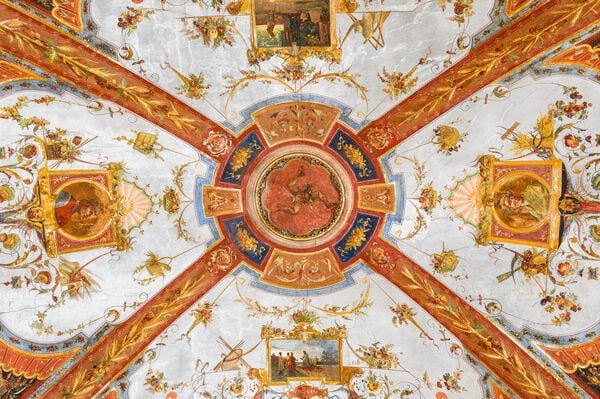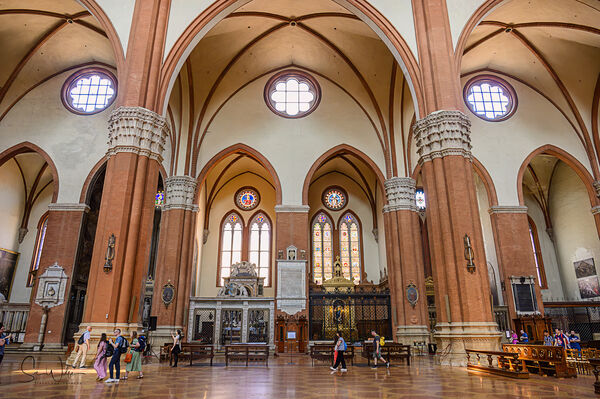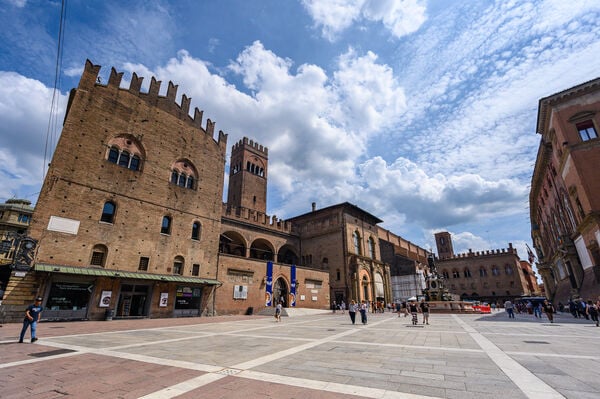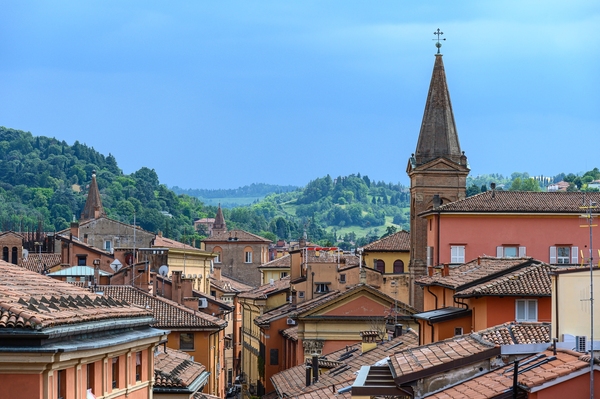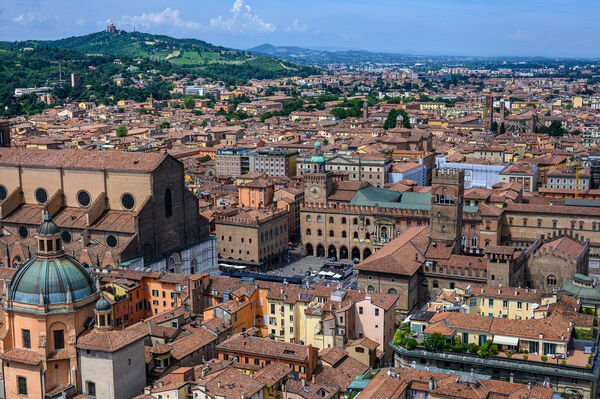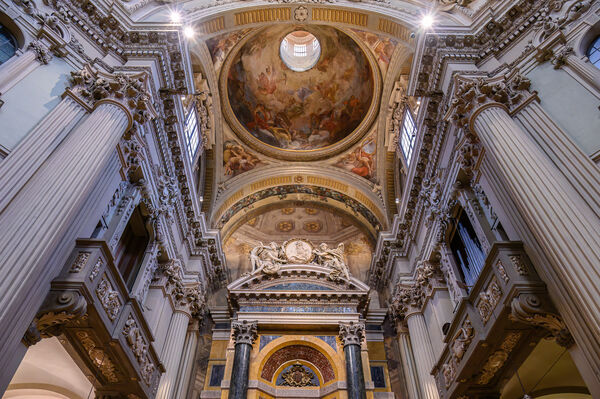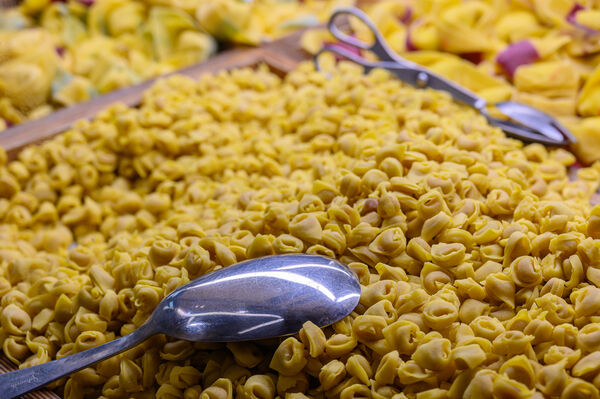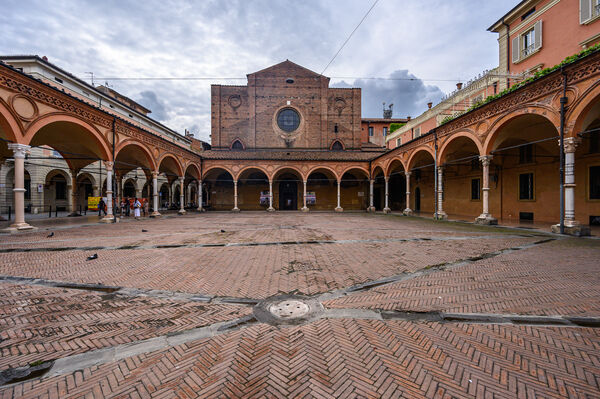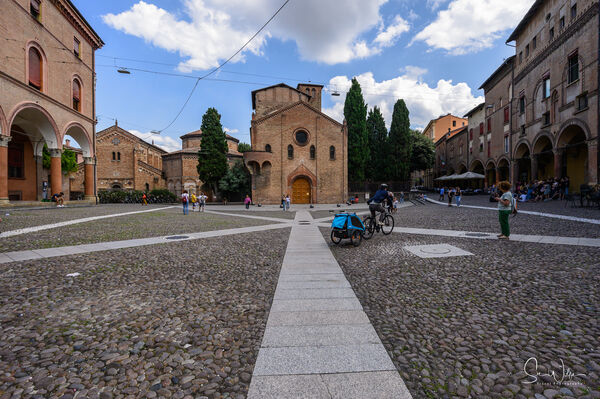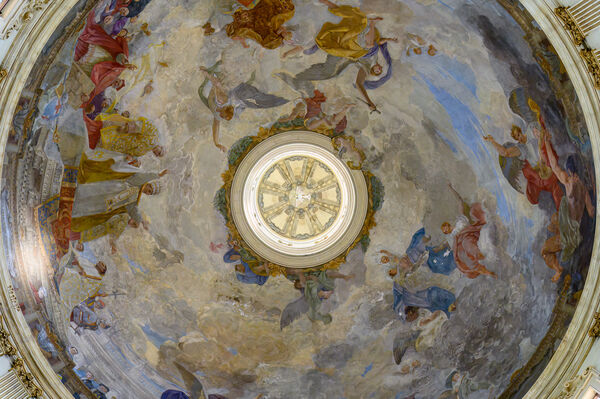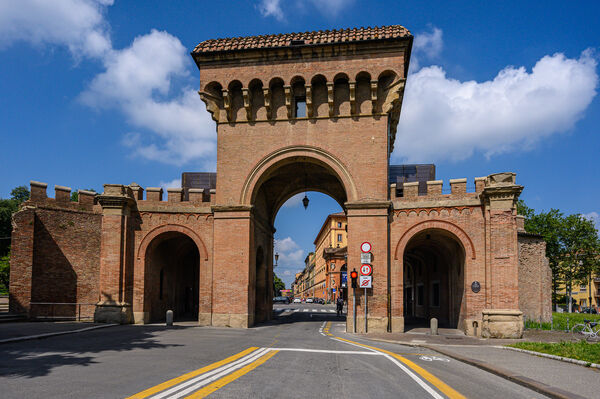Explore the top spots in
 Bologna
Bologna
41 photo spots 387 inspiring images 1 contributor
Top places to photograph in Bologna in 2024
These are the very best Bologna Instagram spots, curated by the PhotoHound team. If you've got limited time here, these are the must-see locations to shoot while you're in Bologna!
Basilica Di San Domenico
Dominic de Guzmàn, or St. Dominic was the founder of the Dominican Order. He was born in Spain but eventually made his way to a small church at the outskirts of Bologna in 1220. After his death in 1221, the Dominicans bought all the surrounding plots of land, and the church was expanded with a new monastic complex.
In 1233, the remains of St. Dominic were moved to a simple sarcophagus within the Basilica. However, so many pilgrims visited the tomb that plans were made for a much larger monument. Nicola Pisano started work on the new tomb in 1265. The tomb was once again relocated in 1411 and sculptors led by Niccolò dell’Arca added a crowning to the flat top of the sarcophagus. You can find the chapel halfway down the Basilica on the right. With construction of the Arca di San Domenico spanning several hundred years, various artists worked on the project including a young Michelangelo. The Basilica is still the last stop of the Dominican Camino which begins in the saint’s hometown of Caleruega, Spain.
Rosary Chapel is the largest chapel on the left side of the nave. The two main frescoes (the Assumption and Heaven and Earth Praising the Madonna) were painted by Colonna and Mitelli. The chapel also contains 15 paintings that surround the statue of the Virgin and represent the Mysteries of the Rosary.
Many of the side chapels were built in the 15th century and contain art treasures created by some of Italy’s greatest artists.
Wolfgang Amadeus Mozart played the organ in this church while studying under Padre Martini in 1769. On display is the score to No. 134 written by Mozart. The organ dates back to 1759.
In the church’s piazza are the tombs of law scholars Rolandino de’ Passaggeri and Egidio Foscherari, as well as statues of St. Dominic and the Madonna.
Learn more about Basilica Di San Domenico
In 1233, the remains of St. Dominic were moved to a simple sarcophagus within the Basilica. However, so many pilgrims visited the tomb that plans were made for a much larger monument. Nicola Pisano started work on the new tomb in 1265. The tomb was once again relocated in 1411 and sculptors led by Niccolò dell’Arca added a crowning to the flat top of the sarcophagus. You can find the chapel halfway down the Basilica on the right. With construction of the Arca di San Domenico spanning several hundred years, various artists worked on the project including a young Michelangelo. The Basilica is still the last stop of the Dominican Camino which begins in the saint’s hometown of Caleruega, Spain.
Rosary Chapel is the largest chapel on the left side of the nave. The two main frescoes (the Assumption and Heaven and Earth Praising the Madonna) were painted by Colonna and Mitelli. The chapel also contains 15 paintings that surround the statue of the Virgin and represent the Mysteries of the Rosary.
Many of the side chapels were built in the 15th century and contain art treasures created by some of Italy’s greatest artists.
Wolfgang Amadeus Mozart played the organ in this church while studying under Padre Martini in 1769. On display is the score to No. 134 written by Mozart. The organ dates back to 1759.
In the church’s piazza are the tombs of law scholars Rolandino de’ Passaggeri and Egidio Foscherari, as well as statues of St. Dominic and the Madonna.
Portici of Via Farini
The “City of Porticoes” is home to 40 kilometers (25 miles) of covered passageways. Used to protect the public from sun and rain, they were an extension of the home. They became so popular in Bologna that a law was passed in 1288 requiring all new buildings to include them in their construction.
While I found all the porticoes beautiful, they are not all created equal. Wealthy families competed for the tallest tower in town, and the porticoes were no exception to this friendly competition. They took great pride in creating the most ornate entrance—with marble flooring, wonderful frescoes, and tilework taking their front porch to a new level.
In 2021, UNESCO declared twelve of the porticoes and their surrounding areas as World Heritage sites due to their cultural and artistic significance.
Learn more about Portici of Via Farini
While I found all the porticoes beautiful, they are not all created equal. Wealthy families competed for the tallest tower in town, and the porticoes were no exception to this friendly competition. They took great pride in creating the most ornate entrance—with marble flooring, wonderful frescoes, and tilework taking their front porch to a new level.
In 2021, UNESCO declared twelve of the porticoes and their surrounding areas as World Heritage sites due to their cultural and artistic significance.
Basilica di San Petronio
Dominating the Piazza Maggiore is the Basilica of San Petronio—the largest and most important church in Bologna. Construction began in 1390 with the central nave vaults being completed in 1658. The church is Gothic in style and quite large (capacity 28,000)—earning a spot on the “Largest churches in Europe” list. It is said it would have been larger than St. Peter’s in Rome had not Pope Pius IV put a stop to construction by using the funds for Bologna’s new university, The Archiginnasio. That explains the half-finished façade—money was diverted and only the bottom half of the basilica was clad in rose and white marble from Verona.
The church was dedicated to Petronius, the city’s patron saint. There are 22 side chapels in total. The second chapel on the left contains the Saint’s relics. It contains two organs—the oldest dates to 1475 and is still in working order. Another popular chapel is the Cappella dei Magi (Bolognini). The chapel is completely covered in frescoes which represent the life of St. Petronio, paradise, and hell. One of the frescos depicts the Prophet Mohammed in hell being tortured by a demon. The painting has offended many Muslims—so much so that Islamist terrorist groups tried to blow up the Basilica in 2002 and 2006. The Basilica is now under surveillance 24/7. The chapels were decorated by various artists including Aspertini, Giovanni da Modena, Lorenzo Costa, and Francesco Francia. Each chapel is different and ranges from modest to very ornate.
On the left side of the church is Cassini’s 66.8-meter Meridian Line. Sunlight enters through a hole in the church wall and at noon falls exactly on the meridian line. The position of the projected image of the sun, among other things, accurately calculates the timing of equinoxes and solstices.
The entrance, “Porta Magna,” was designed by Jacopo della Quercia. The pillars and architrave depict events from the Old and New Testament. The tympanum depicts the Madonna and Child, Saint Ambrosio, and Saint Petronio. The right and left portals feature reliefs by Aspertini, Lombardi and Properzia de’ Rossi (one of the few female sculptors of the Renaissance). The left is the “Risen Christ with Soldiers” by Lombardi and the right lunette contains “The Deposition” by Aspertini.
The church has been the backdrop for many historical events. Charles V chose San Petronio as the location for his crowning as Holy Roman Emperor in 1530. The basilica also hosted the IX and X sessions of the Council of Trent due to the plague raging in Trent.
Learn more about Basilica di San Petronio
The church was dedicated to Petronius, the city’s patron saint. There are 22 side chapels in total. The second chapel on the left contains the Saint’s relics. It contains two organs—the oldest dates to 1475 and is still in working order. Another popular chapel is the Cappella dei Magi (Bolognini). The chapel is completely covered in frescoes which represent the life of St. Petronio, paradise, and hell. One of the frescos depicts the Prophet Mohammed in hell being tortured by a demon. The painting has offended many Muslims—so much so that Islamist terrorist groups tried to blow up the Basilica in 2002 and 2006. The Basilica is now under surveillance 24/7. The chapels were decorated by various artists including Aspertini, Giovanni da Modena, Lorenzo Costa, and Francesco Francia. Each chapel is different and ranges from modest to very ornate.
On the left side of the church is Cassini’s 66.8-meter Meridian Line. Sunlight enters through a hole in the church wall and at noon falls exactly on the meridian line. The position of the projected image of the sun, among other things, accurately calculates the timing of equinoxes and solstices.
The entrance, “Porta Magna,” was designed by Jacopo della Quercia. The pillars and architrave depict events from the Old and New Testament. The tympanum depicts the Madonna and Child, Saint Ambrosio, and Saint Petronio. The right and left portals feature reliefs by Aspertini, Lombardi and Properzia de’ Rossi (one of the few female sculptors of the Renaissance). The left is the “Risen Christ with Soldiers” by Lombardi and the right lunette contains “The Deposition” by Aspertini.
The church has been the backdrop for many historical events. Charles V chose San Petronio as the location for his crowning as Holy Roman Emperor in 1530. The basilica also hosted the IX and X sessions of the Council of Trent due to the plague raging in Trent.
Piazza del Nettuno
Front and center in the Piazza del Nettuno is the Fontana del Nettuno which was sculpted by Giambologna in 1556. The bronze sculpture features “Il Gigante” (Neptune) and four putti (cherubs) representing the winds. The fountain also features four voluptuous mermaids riding dolphins. The dolphins represent the Ganges, the Nile, the Amazon, and the Danube rivers.
To remind citizens of who was in charge, Pope Pius IV chose Neptune as a symbol—just as Neptune was the master of the seas, the Pope was the master of Bologna. The inscription at the fountain base translated reads “to embellish the square for the use of the people made with public money.”
With the not so friendly relationship with the Pope, the Bolognesi took delight in the fact that the Papacy thought the sculpture profane. The story goes that Giambologna wanted to make Neptune’s private parts somewhat larger, but this was forbidden by the church. From a certain angle, the thumb of the left hand takes on a somewhat different aspect and this is supposed to be Giambologna’s revenge. At one point Neptune was “robed.” However, today you can see him in all his glory.
The Fountain of Neptune is located right off the Piazza Maggiore, sandwiched between the Sala Borsa and Palazzo Re Enzo.
The trident may look familiar to you—it is the symbol of the Maserati car company.
Learn more about Piazza del Nettuno
To remind citizens of who was in charge, Pope Pius IV chose Neptune as a symbol—just as Neptune was the master of the seas, the Pope was the master of Bologna. The inscription at the fountain base translated reads “to embellish the square for the use of the people made with public money.”
With the not so friendly relationship with the Pope, the Bolognesi took delight in the fact that the Papacy thought the sculpture profane. The story goes that Giambologna wanted to make Neptune’s private parts somewhat larger, but this was forbidden by the church. From a certain angle, the thumb of the left hand takes on a somewhat different aspect and this is supposed to be Giambologna’s revenge. At one point Neptune was “robed.” However, today you can see him in all his glory.
The Fountain of Neptune is located right off the Piazza Maggiore, sandwiched between the Sala Borsa and Palazzo Re Enzo.
The trident may look familiar to you—it is the symbol of the Maserati car company.
Torre dell'Orologio
The Torre dell’Orologio was added to the Palazzo D’Accursio in 1444. With the installation of the first clock, a bell rang every hour which provided a reference point for all clocks in Bologna. The clock also indicated the phases of the moon, solar rotation, and signs of the zodiac. On the hour a carousel featuring the Three Magi and an angel passed and bowed in front of the statue of the Madonna with Child. You can now see these figures in the Collezioni Comunali d’Art located in the ceremonial halls of Palazzo d’Accursio.
The face of the clock is 6.4 meters wide, one of the largest in Italy. The tower had to be raised 10 meters to accommodate the clock’s size.
Bell ringing is a tradition in Bologna. A small bell “concert” has at least 4 bells of different sizes and pitches tuned to a major chord. The Torre dell’Orologio’s bell concert contains 5 bells with different sounds: the piccola (din), the quarta (high den), the mezzanella (den), the mezzana (dan), and the grossa (don). The bronze bells were cast at the Brighenti foundry which was in business until 1958.
Learn more about Torre dell'Orologio
The face of the clock is 6.4 meters wide, one of the largest in Italy. The tower had to be raised 10 meters to accommodate the clock’s size.
Bell ringing is a tradition in Bologna. A small bell “concert” has at least 4 bells of different sizes and pitches tuned to a major chord. The Torre dell’Orologio’s bell concert contains 5 bells with different sounds: the piccola (din), the quarta (high den), the mezzanella (den), the mezzana (dan), and the grossa (don). The bronze bells were cast at the Brighenti foundry which was in business until 1958.
Le Due Torri
The Leaning Tower of Pisa is not the only leaning tower in Italy. Two of the most visited towers in Bologna—the Asinelli Tower and Garisenda Tower—also have that problem. The towers are named after the families who are credited for constructing the towers between 1109 and 1119 and are two of the 20 towers that have survived through the centuries. At one time Bologna was thought to have had as many as 180 towers. As the city grew the towers were cut down, demolished or incorporated into other buildings.
The Asinelli Tower is the tallest medieval tower in the world (97.2 meters or 319 feet) and the only tower of the two you can climb. It is thought the two families had a competition on who could build the highest tower. Garisenda Tower was originally 60 meters tall but had to be shortened for fear of it collapsing due to the tilt. This tower was mentioned by Dante in the “Divine Comedy.” In case you want to compare Garisenda to Pisa, Garisenda’s incline is 4 degrees, Pisa is 3.97 degrees. At one time, the two towers were connected by wooden scaffolding placed 30 meters above the ground.
Besides signaling how wealthy the family was, the towers have had many uses—defensive fortification, a prison, scientific experiments, and a sight post during WWII. Both have survived numerous fires, lightning strikes, and earthquakes.
The two towers are recognized as the symbols of Bologna and are located in the heart of the city on the ancient Via Emilia. The intersection leads to five of the city gates located in the old ring wall.
Learn more about Le Due Torri
The Asinelli Tower is the tallest medieval tower in the world (97.2 meters or 319 feet) and the only tower of the two you can climb. It is thought the two families had a competition on who could build the highest tower. Garisenda Tower was originally 60 meters tall but had to be shortened for fear of it collapsing due to the tilt. This tower was mentioned by Dante in the “Divine Comedy.” In case you want to compare Garisenda to Pisa, Garisenda’s incline is 4 degrees, Pisa is 3.97 degrees. At one time, the two towers were connected by wooden scaffolding placed 30 meters above the ground.
Besides signaling how wealthy the family was, the towers have had many uses—defensive fortification, a prison, scientific experiments, and a sight post during WWII. Both have survived numerous fires, lightning strikes, and earthquakes.
The two towers are recognized as the symbols of Bologna and are located in the heart of the city on the ancient Via Emilia. The intersection leads to five of the city gates located in the old ring wall.
Santa Maria Della Vita
Nestled in the Quadrilatero district is the Santa Maria Della Vita. Construction of the current church began in 1687. The dome was finished in 1787 and is visible from the Piazza Maggiore. The church was originally small and served the adjoining hospital. The Sanctuary, under Napoleon, became a museum at the end of the 18th century when religious communities were disbanded. It was reopened and is now considered the most important example of Baroque art in Bologna.
It is probably best known for the Compianto sul Cristo Morto (Lamentation over the Dead Christ) by Niccolò dell’Arca, dating back to the 15th century. The sculptures have been called the “Scream of Stone,” and it is easy to see why. The life-size grieving mourners at the death of Christ exhibit expressions of raw grief. It is thought that dell’Arca may have studied the faces of the sick and suffering to achieve such a result. Included in the grouping is Mary Magdalene, Mary of Cleophas, the Apostle John, the Virgin Mary, Mary Salome and Nicodemus.
The exterior is plain with two statues of the founders overlooking the street. However, the interior is ornate with a large dome and several side chapels. The Compianto sul Cristo Morto is in a chapel to the right of the altar.
Learn more about Santa Maria Della Vita
It is probably best known for the Compianto sul Cristo Morto (Lamentation over the Dead Christ) by Niccolò dell’Arca, dating back to the 15th century. The sculptures have been called the “Scream of Stone,” and it is easy to see why. The life-size grieving mourners at the death of Christ exhibit expressions of raw grief. It is thought that dell’Arca may have studied the faces of the sick and suffering to achieve such a result. Included in the grouping is Mary Magdalene, Mary of Cleophas, the Apostle John, the Virgin Mary, Mary Salome and Nicodemus.
The exterior is plain with two statues of the founders overlooking the street. However, the interior is ornate with a large dome and several side chapels. The Compianto sul Cristo Morto is in a chapel to the right of the altar.
Quadrilatero
Just to the east of Piazza Maggiore is the Quadrilatero District. This old grid of streets is full of food shops, restaurants, and markets. In this district you will find juicy peaches and cherries, delicious pastries, navel-shaped handmade pasta, shaved Parma ham, Bolognese Mortadella and blocks of black rind parmesan. Note: Bologna is not an American lunchmeat—its origin is Bologna, Italy.
The covered market has been converted to the Mercato di Mezzo—a food hall where you can take out or sit and eat at communal tables.
Learn more about Quadrilatero
The covered market has been converted to the Mercato di Mezzo—a food hall where you can take out or sit and eat at communal tables.
Santa Maria Dei Servi
The Basilica di Santa Maria dei Servi was founded in 1346 by the Servites of Maria. The order was founded by a group of wealthy cloth traders in Florence. While the church was started in the 1300s, it took almost two centuries to complete.
The exterior of the church is rather plain, but the portico is unique. The courtyard is completely enclosed by a wide portico with Roman arches in Veronese marble. Friar Andrea Manfredi, architect of the church, was also responsible for expanding the monastery as well as building the porticoes. In the simple brick facade, you will see a circular oculus for the rose window that was never built.
The interior of the church forms a Latin cross and is Gothic in style. Not to be missed are the “Holy Virgin Enthroned” and the 14th century frescoes by Vitale da Bologna and Lippi di Dalmasio. The Annunciation of Mary altarpiece was crafted by Giovanni Angelo Montorsoli, a student of Michelangelo.
In the first chapel is a large panel of the Madonna and Child attributed to Cimabue (Bencivieni di Pepo). However, there is a debate as to whether it was painted by Cimabue or by his students.
The markets and the Feast of Santa Lucia are held under the porticoes during Christmas season. During the holidays you will find Bolognese sweets, a Christmas tree with children’s letters and objects of all kinds.
The Santa Maria dei Servi has a long music tradition. In the 17th century there were four organs. Today, the music chapel houses the pipe organ Tamburini built in 1900. The church is often used for classical music concerts held throughout the year.
The Bell Tower is 52 meters high and dates back to 1453. It is easily seen from the Asinelli Tower.
Following the arrival of Napoleon’s troops in Bologna (1796), the church was temporarily used for military barracks.
Learn more about Santa Maria Dei Servi
The exterior of the church is rather plain, but the portico is unique. The courtyard is completely enclosed by a wide portico with Roman arches in Veronese marble. Friar Andrea Manfredi, architect of the church, was also responsible for expanding the monastery as well as building the porticoes. In the simple brick facade, you will see a circular oculus for the rose window that was never built.
The interior of the church forms a Latin cross and is Gothic in style. Not to be missed are the “Holy Virgin Enthroned” and the 14th century frescoes by Vitale da Bologna and Lippi di Dalmasio. The Annunciation of Mary altarpiece was crafted by Giovanni Angelo Montorsoli, a student of Michelangelo.
In the first chapel is a large panel of the Madonna and Child attributed to Cimabue (Bencivieni di Pepo). However, there is a debate as to whether it was painted by Cimabue or by his students.
The markets and the Feast of Santa Lucia are held under the porticoes during Christmas season. During the holidays you will find Bolognese sweets, a Christmas tree with children’s letters and objects of all kinds.
The Santa Maria dei Servi has a long music tradition. In the 17th century there were four organs. Today, the music chapel houses the pipe organ Tamburini built in 1900. The church is often used for classical music concerts held throughout the year.
The Bell Tower is 52 meters high and dates back to 1453. It is easily seen from the Asinelli Tower.
Following the arrival of Napoleon’s troops in Bologna (1796), the church was temporarily used for military barracks.
Le Sette Chiese
Le Sette Chiese was originally a complex of seven churches in one. The complex dates to the 5th century and may have been founded by Bishop Petronius. Only four of the interlocking churches remain—Chiesa del Crocifisso, Church of San Sepolcro, Santi Vitale e Agricola, and Martyrium.
The Chiesa del Crocifisso has changed the most since its construction in the 8th century. The church was destroyed during a Hungarian invasion in the 10th century but was rebuilt by the Benedictines in the Romanesque style with a single nave. The presbytery, remodeled in the 17th century, features the Crucifix by Simone dei Crocifissi (1380). Steps lead down to a crypt which was built to house the relics of the early Bolognese martyrs Vitale and Agricola. Their remains are contained in a golden urn on the altar. Every morning and evening, mass is celebrated in the crypt by monks from the Benedictine-Olivetan order.
The church of San Sepolcro was modelled on Jerusalem’s Holy Sepulcher. It is the most famous of the churches. It has an octagonal base with a twelve-sided cupola. Some of the columns used in the construction are from the former temple to Isis located on this site. The black marble column symbolizes the column where Jesus was whipped. The body of St. Petronius was found here in the 12th century and was transferred to the Basilica of San Petronio in 2000 to be reunited with the saint’s head. The large pulpit takes center stage in the church.
Santi Vitale e Agricola is the oldest church in Bologna. It is brick and is very simple in appearance with no transept. It is dedicated to the first Bolognese martyrs, Vitale and Agricola, who were persecuted in the time of Diocletian around 305 AD. It is believed that Agricola, a Roman Christian, converted his slave, Vitalis, to Christianity. Vitalis was executed in the amphitheater and Agricola, who refused to give up his religion, was crucified. In the 5th century a tomb in the church was found with the inscription “Symon.” Many thought it was the tomb of St. Peter. When pilgrims began to visit the church in Bologna instead of going to Rome, the Pope filled the church with dirt and it stayed that way for more than 70 years. Eventually it was reopened and reconstructed.
Adjoining the Santi Vitale e Agricola is the Cortile di Pilato. The courtyard contains a large marble basin erroneously believed to have been used by Pontius Pilate to wash his hands during the trial of Jesus. Near one of the columns is the image of a rooster, referring to the denial of St. Peter.
Behind the Cortile di Pilato is the Martyrium, also known as the Church of the Holy Cross. Very little is known about its history. From the time of the Crusades until 1950, a relic of the Holy Cross was kept in the central chapel. There is also a Benedictine cloister with two tiers of loggias that leads to the Chapel of the Bandage.
Learn more about Le Sette Chiese
The Chiesa del Crocifisso has changed the most since its construction in the 8th century. The church was destroyed during a Hungarian invasion in the 10th century but was rebuilt by the Benedictines in the Romanesque style with a single nave. The presbytery, remodeled in the 17th century, features the Crucifix by Simone dei Crocifissi (1380). Steps lead down to a crypt which was built to house the relics of the early Bolognese martyrs Vitale and Agricola. Their remains are contained in a golden urn on the altar. Every morning and evening, mass is celebrated in the crypt by monks from the Benedictine-Olivetan order.
The church of San Sepolcro was modelled on Jerusalem’s Holy Sepulcher. It is the most famous of the churches. It has an octagonal base with a twelve-sided cupola. Some of the columns used in the construction are from the former temple to Isis located on this site. The black marble column symbolizes the column where Jesus was whipped. The body of St. Petronius was found here in the 12th century and was transferred to the Basilica of San Petronio in 2000 to be reunited with the saint’s head. The large pulpit takes center stage in the church.
Santi Vitale e Agricola is the oldest church in Bologna. It is brick and is very simple in appearance with no transept. It is dedicated to the first Bolognese martyrs, Vitale and Agricola, who were persecuted in the time of Diocletian around 305 AD. It is believed that Agricola, a Roman Christian, converted his slave, Vitalis, to Christianity. Vitalis was executed in the amphitheater and Agricola, who refused to give up his religion, was crucified. In the 5th century a tomb in the church was found with the inscription “Symon.” Many thought it was the tomb of St. Peter. When pilgrims began to visit the church in Bologna instead of going to Rome, the Pope filled the church with dirt and it stayed that way for more than 70 years. Eventually it was reopened and reconstructed.
Adjoining the Santi Vitale e Agricola is the Cortile di Pilato. The courtyard contains a large marble basin erroneously believed to have been used by Pontius Pilate to wash his hands during the trial of Jesus. Near one of the columns is the image of a rooster, referring to the denial of St. Peter.
Behind the Cortile di Pilato is the Martyrium, also known as the Church of the Holy Cross. Very little is known about its history. From the time of the Crusades until 1950, a relic of the Holy Cross was kept in the central chapel. There is also a Benedictine cloister with two tiers of loggias that leads to the Chapel of the Bandage.
Santuario della Madonna di San Luca
Southwest of Bologna, on Colle della Guardia overlooking the Apennines, is the Santuario della Madonna di San Luca. It is a destination for pilgrims who revere the icon of the Virgin and Child known as di San Luca. The painting, attributed to Luke the Evangelist, was carried up the mountain by the Greek pilgrim Theokoles. The icon was eventually entrusted to Angelica Bonfantini who decided to live as a hermit on Monte della Guardia. She gave the land she owned in exchange for help in building the church and food for the rectory (1192). It should be noted there are several versions of how the icon made its way to Bologna.
The “Miracle of the Rain” is associated with this icon. In 1433, an extremely rainy season threated to ruin the crops. The Jurisconsult asked for the Madonna and Child to be brought into the city to the Council of Elders. As the icon entered the city the rain stopped. A three-day celebration followed. The procession has been repeated every year since, except for 1849 during Austrian occupation and in 1944 during WWII. The celebrations begin the Saturday preceding the fifth Sunday after Easter. After spending a week in the city, the image is returned via the portico of San Luca.
The sanctuary was enlarged over the years with major renovations occurring in 1481, 1603, and 1708. The current Baroque-styled oval building began in 1723 and was completed in 1748. On March 25, 1765, the cardinal archbishop Vincenzo Malvezzi inaugurated the new sanctuary. The frescoes in the dome were not added until 1918 by the Florentine painter Giuseppe Cassioli. The basilica has a Greek cross plan and the presbytery, where the Madonna is kept, is raised.
The Sanctuary of San Luca was declared a national monument in 1874.
Learn more about Santuario della Madonna di San Luca
The “Miracle of the Rain” is associated with this icon. In 1433, an extremely rainy season threated to ruin the crops. The Jurisconsult asked for the Madonna and Child to be brought into the city to the Council of Elders. As the icon entered the city the rain stopped. A three-day celebration followed. The procession has been repeated every year since, except for 1849 during Austrian occupation and in 1944 during WWII. The celebrations begin the Saturday preceding the fifth Sunday after Easter. After spending a week in the city, the image is returned via the portico of San Luca.
The sanctuary was enlarged over the years with major renovations occurring in 1481, 1603, and 1708. The current Baroque-styled oval building began in 1723 and was completed in 1748. On March 25, 1765, the cardinal archbishop Vincenzo Malvezzi inaugurated the new sanctuary. The frescoes in the dome were not added until 1918 by the Florentine painter Giuseppe Cassioli. The basilica has a Greek cross plan and the presbytery, where the Madonna is kept, is raised.
The Sanctuary of San Luca was declared a national monument in 1874.
Porta Saragozza
Porta Saragozza was one of 12 gates in Bologna’s outer medieval wall known as “The Circla.” The gate was built in the 13-14th centuries with a drawbridge over the moat to help secure the city from external attacks.
This entrance to the city became popular after the Portico di San Luca was built and used in the yearly procession of the Madonna and Child icon to city center. At that point, the Saragozza Gate became known as the Porta Sacra or Porta dei Pellegrini (Gate of Pilgrims). Today, inside you can find the Museum of the Blessed Virgin of San Luca which preserves the link between the two.
In 1859, the gate was remodeled by architect Giuseppe Mengoli who connected the main arch to the towers with another set of pedestrian arches, giving it a castle-like look.
Learn more about Porta Saragozza
This entrance to the city became popular after the Portico di San Luca was built and used in the yearly procession of the Madonna and Child icon to city center. At that point, the Saragozza Gate became known as the Porta Sacra or Porta dei Pellegrini (Gate of Pilgrims). Today, inside you can find the Museum of the Blessed Virgin of San Luca which preserves the link between the two.
In 1859, the gate was remodeled by architect Giuseppe Mengoli who connected the main arch to the towers with another set of pedestrian arches, giving it a castle-like look.
We hope you enjoy photographing these great Bologna Instagram locations. We love seeing your images of the most Instagrammable places in Bologna, so make sure to share your images on PhotoHound and tag us on Instagram @photohound and hashtag #photohound for a chance to be featured.
